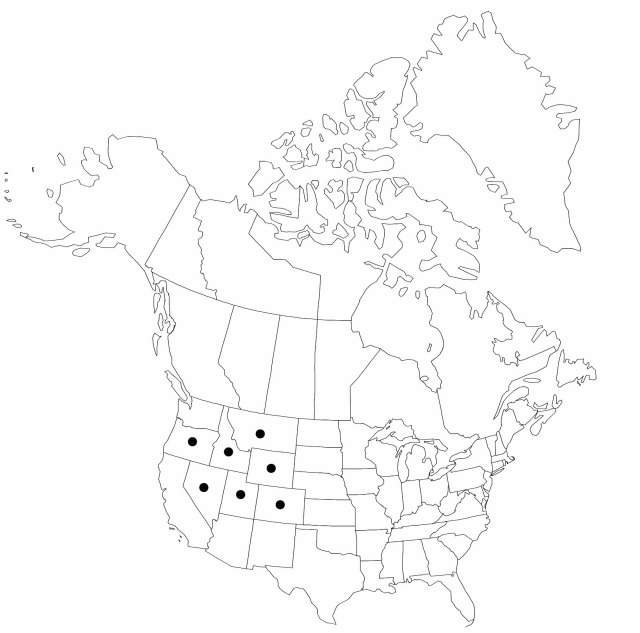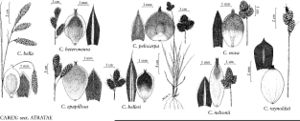Difference between revisions of "Carex pelocarpa"
Rhodora 39: 492. 1937.
FNA>Volume Importer |
imported>Volume Importer |
||
| (6 intermediate revisions by 2 users not shown) | |||
| Line 6: | Line 6: | ||
|place=39: 492. 1937 | |place=39: 492. 1937 | ||
|year=1937 | |year=1937 | ||
| + | }} | ||
| + | |special_status={{Treatment/ID/Special_status | ||
| + | |code=F | ||
| + | |label=Illustrated | ||
| + | }}{{Treatment/ID/Special_status | ||
| + | |code=E | ||
| + | |label=Endemic | ||
}} | }} | ||
|basionyms= | |basionyms= | ||
| Line 11: | Line 18: | ||
|name=Carex nova var. pelocarpa | |name=Carex nova var. pelocarpa | ||
|authority=(F. J. Hermann) Dorn | |authority=(F. J. Hermann) Dorn | ||
| + | |rank=variety | ||
}} | }} | ||
|hierarchy=Cyperaceae;Carex;Carex sect. Racemosae;Carex pelocarpa | |hierarchy=Cyperaceae;Carex;Carex sect. Racemosae;Carex pelocarpa | ||
| Line 26: | Line 34: | ||
|elevation=2700–3700 m | |elevation=2700–3700 m | ||
|distribution=Colo.;Idaho;Mont.;Nev.;Oreg.;Utah;Wyo. | |distribution=Colo.;Idaho;Mont.;Nev.;Oreg.;Utah;Wyo. | ||
| − | |discussion=<p>Carex pelocarpa has often been treated within C. nova; it is distinguished on the basis of perigynia, pistillate scales, and ecology.</p> | + | |discussion=<p><i>Carex pelocarpa</i> has often been treated within <i>C. nova</i>; it is distinguished on the basis of perigynia, pistillate scales, and ecology.</p> |
|tables= | |tables= | ||
|references= | |references= | ||
| Line 35: | Line 43: | ||
-->{{#Taxon: | -->{{#Taxon: | ||
name=Carex pelocarpa | name=Carex pelocarpa | ||
| − | |||
|authority=F. J. Hermann | |authority=F. J. Hermann | ||
|rank=species | |rank=species | ||
| Line 49: | Line 56: | ||
|publication title=Rhodora | |publication title=Rhodora | ||
|publication year=1937 | |publication year=1937 | ||
| − | |special status= | + | |special status=Illustrated;Endemic |
| − | |source xml=https:// | + | |source xml=https://bitbucket.org/aafc-mbb/fna-data-curation/src/2e0870ddd59836b60bcf96646a41e87ea5a5943a/coarse_grained_fna_xml/V23/V23_744.xml |
|genus=Carex | |genus=Carex | ||
|section=Carex sect. Racemosae | |section=Carex sect. Racemosae | ||
Latest revision as of 20:42, 5 November 2020
Plants cespitose. Culms 10–40 cm, smooth. Leaves 3–4 mm wide. Inflorescences: proximal bracts shorter than, sometimes equaling or, occasionally, exceeding inflorescences; spikes overlapping, contiguous, forming a dense terminal cluster or, sometimes, proximal spikes separate and distinct, sessile, short-oblong, 7–10 × 5–7 mm; lateral 2–3 spikes pistillate; terminal spike gynecandrous. Pistillate scales dark brown or black to margins, lanceolate, shorter or longer than, and narrower than, perigynia, midvein same color as body, inconspicuous, apex usually acute, occasionally short-mucronate. Perigynia ascending, glossy reddish brown, often with yellowish or greenish brown margins, veinless, obovate or circular, 3.5–4.5 × 2.5–3 mm, apex abruptly beaked, smooth; beak 0.5–0.8 mm, deeply bidentate, smooth. Achenes filling proximal 1/2 or less of perigynia.
Phenology: Fruiting Jul–Aug.
Habitat: Alpine slopes, ridge crests, rocky lakeshores
Elevation: 2700–3700 m
Distribution

Colo., Idaho, Mont., Nev., Oreg., Utah, Wyo.
Discussion
Carex pelocarpa has often been treated within C. nova; it is distinguished on the basis of perigynia, pistillate scales, and ecology.
Selected References
None.
